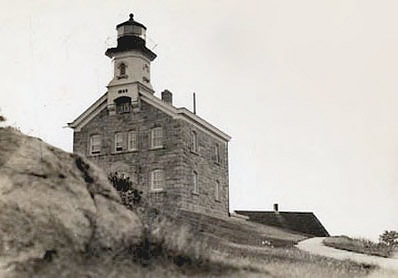

Daniel Patrick (sometimes spelled Partrick) was born in Ireland, but served as a British officer in the Pequot War of 1637. He next appears in 1639, when, with Robert Feaks, he purchased Greenwich from an Indian sachem, thus becoming the first settlers of that town. The founders of Greenwich were placed in the difficult position of being placed on the border between the colonial claims of both the English and Dutch governments while residing in the midst of hostile native populations.
 Photo: View northeast showing façade and west elevation (US Coast Guard)
Photo: View northeast showing façade and west elevation (US Coast Guard)
The latter eventually drove Patrick to swear allegiance to the States General, West India Company, and the governmental representatives of New Netherlands on April 9, 1642, in an effort to gain protections from the natives. Patrick was killed by a Dutch officer after a dispute over an Indian raid. He is remembered today by the three islands off the Greenwich coast which were named Great Captain, Little Captain, and Wee Captain in his honor.
The first lighthouse was built on Great Captain Island in 1830 and it was replaced by the current structure in 1868. The lighthouse was listed in the National Register of Historic Places in 1991.
Clouette, Bruce and Roth, Matthew. "Great Captain Island Light." National Register of Historic Places nomination. 1991. Karmazinas, Lucas. "The Irish in Connecticut." Historic Resource Inventory Narrative. 2014.
Great Captain Island Lighthouse is a combined dwelling and light tower. The walls of the 2 1/2-story lighthouse are a random ashlar of rough-hewn gray granite blocks, with the corners finished with raised quoins. Similar stone forms a water table above the high basement story and the raised sills, jambs, and heads of the segmental arched windows, which are fitted with six-over-six sash.
The lighthouse's gable roof, which has a deep cornice of Classical moldings, flattens out at the eaves to accommodate an internal rain gutter. There is a small brick chimney toward the center rear. The lighthouse is rectangular in plan with a one-story gable-roofed stuccoed ell.
The lighthouse's main entrance is centered on the three-bay south elevation recessed within a shallow portico. The portico has square chamfered stone pillars framing the entranceway, above which is a lintel which repeats the shape of the main roof. The inside jambs of the portico are finished with wood paneling. The white-painted light tower straddles the peak of the roof on the south end of the lighthouse.
Built of cast-iron plates, it consists of a square base, with large consoles extending down over the stonework of the south elevation, framing a small attic-story window; a watchroom level of eight unequal sides, above which is a wide deck with an iron railing; an octagonal metal and glass lantern stage; and finally, a metal orb-shaped ventilator finial.
Cast-iron decorative details on the light tower include the date in large numerals, just below the base's cornice, and projecting sills and hoodmolds on the segmental arched watchroom windows, three of which are blind openings, with only the south-facing window glazed. The overall height of the lighthouse is 51'.
The lighthouse is located on the southeast corner of Great Captain Island, two miles south of the mainland in Greenwich, Connecticut, where it faces the open waters of Long Island Sound to the south. The land surrounding the lighthouse is mostly open, with some dense low-lying vegetation near the steep slope to the rocky shoreline
of the Sound some 30' below.
Date(s): Built 1868 Style(s): Late Victorian Historic Use: Lighthouse, navigation aid Present Use: Recreation Architect: U.S. Light-House Board Engineers Builder: U.S. Light-House Board Engineers
Accessibility:
Exterior visible from public road.
The Irish experience has had a profound impact on Connecticut's past, and its narrative spans all periods of the state's history and touches every one of its eight counties and 169 towns.
